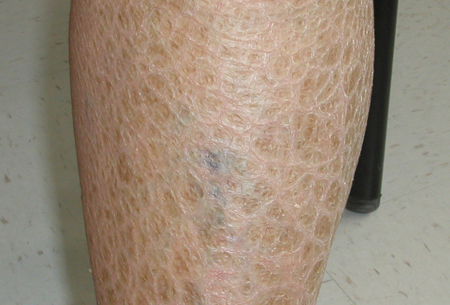Last reviewed: 21 Mar 2025
Last updated: 11 Jan 2022
Summary
Definition
History and exam
Key diagnostic factors
- scaling
- skin changes at birth (in congenital ichthyosis)
- onset in infancy (in ichthyosis vulgaris and X-linked ichthyosis)
- adult onset (in acquired ichthyosis)
- male sex
- family history of ichthyosis
Other diagnostic factors
- history of atopy
- history of lymphoma, diabetes mellitus, systemic lupus erythematosus
- use of clofazimine, lipid-lowering agents, or butyrophenone
- alopecia and ectropion in lamellar ichthyosis
- cryptorchidism and corneal opacities
- deafness, intellectual disability, limb defects, epilepsy, short stature
Risk factors
- positive family history
- parental consanguinity
- use of clofazimine, lipid-lowering agents, or butyrophenone
- history of lymphoma, diabetes mellitus, systemic lupus erythematosus
Diagnostic tests
1st tests to order
- skin biopsy
- serum cholesterol sulfate
- lipoprotein electrophoresis
- steroid sulfatase activity
Tests to consider
- serum phytanic acid
- genetic testing
- CT scan
- serum glucose
- antinuclear antibody
Treatment algorithm
Contributors
Authors
Brittany Craiglow, MD
Associate Adjunct Professor of Dermatology
Yale University
New Haven
CT
Disclosures
BC declares that she is a member of the Foundation for Ichthyosis and Related Skin Types Advisory Board. BC is an author of a reference cited in this topic.
Acknowledgements
Dr Brittany Craiglow would like to gratefully acknowledge Dr Timothy Patton, a previous contributor to this topic.
Disclosures
TP declared that he had no competing interests.
Peer reviewers
David Cassarino, MD, PhD
Assistant Professor
Department of Pathology and Laboratory Medicine
University of California
Los Angeles
CA
Disclosures
DC declares that he has no competing interests.
Thierry Simonart, MD, PhD
Physician
Department of Dermatology
Erasme University Hospital
Brussels
Belgium
Disclosures
TS declares that he has no competing interests.
Use of this content is subject to our disclaimer
